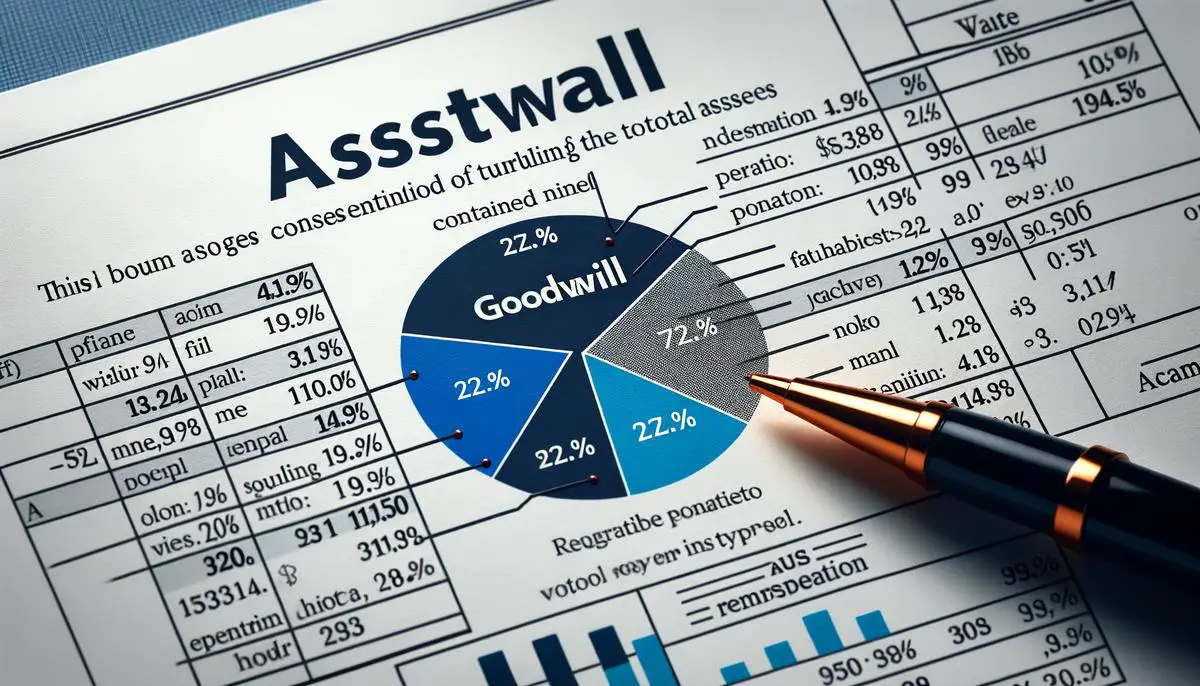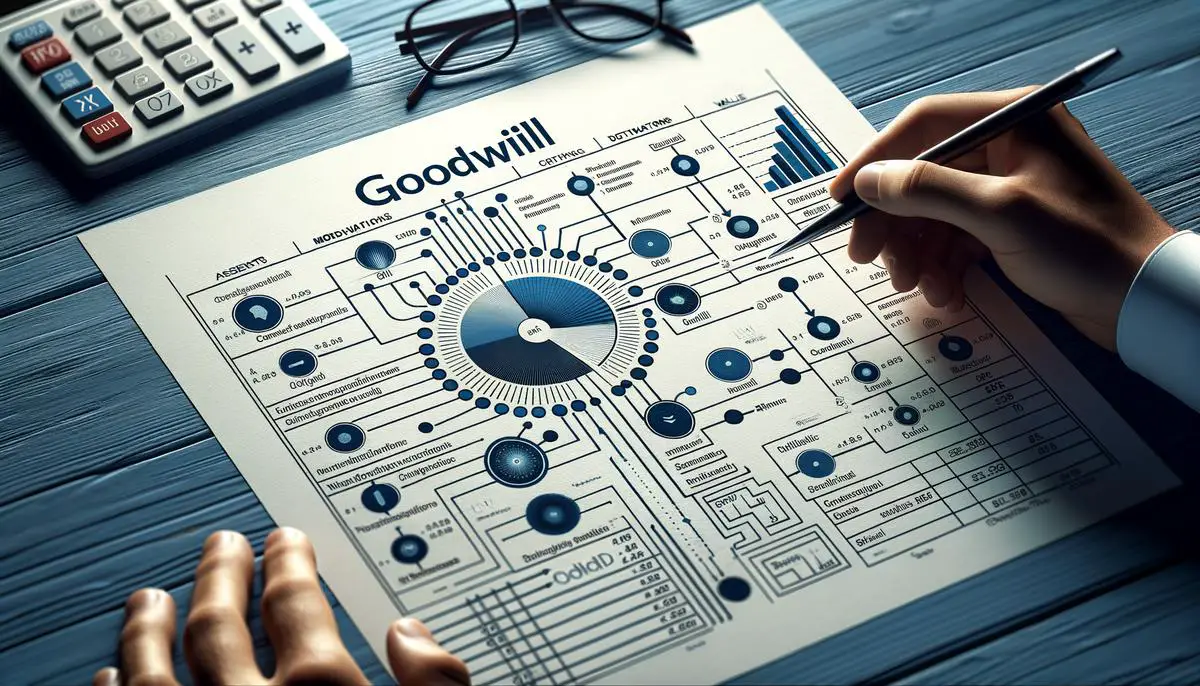Goodwill is a term often discussed in finance and business. It represents a company’s value beyond its tangible assets and liabilities. Understanding this concept involves looking at the true worth of a business, which includes not just what it owns but also the value it holds in the eyes of its customers and stakeholders.
Definition of Goodwill
Goodwill in accounting represents the extra value that comes from purchasing a business above its net identifiable assets. It acknowledges that the business has something special that’s worth paying more for, such as a strong customer base or an excellent market position.
On the balance sheet, goodwill is listed under the assets section as an intangible asset. It adds value to the company’s financial health that can’t be seen at a quick glance but is significant nonetheless.
Reporting goodwill comes with some challenges. Companies have to perform regular checks to ensure its value hasn’t dropped, referred to as “impairment tests.” If the goodwill’s worth decreases, companies need to adjust their financial sheets accordingly, impacting their public valuation.
The inclusion of goodwill in a company’s accounting books can give shareholders and potential investors insight into the additional benefits the company enjoys due to intangible factors. It highlights not just the company’s physical assets but also the strength of relationships and reputation the company has built up over time.

Calculating Goodwill
How is Goodwill Calculated and Recorded?
Calculating goodwill follows a precise formula:
Goodwill = Purchase Price - (Fair Market Value of Identifiable Net Assets).
- Determine the purchase price of the company being acquired. This is the sum paid by Company A to acquire Company B.
- Identify Company B’s assets and determine their fair market value as of the acquisition date. This includes everything from cash to patents.
- Subtract any liabilities from the fair market value of assets to arrive at the net assets at fair valuation.
The difference between the purchase price and the net assets represents goodwill. It signifies the extra value that Company A believes Company B brings into their corporate family, such as a strong reputation or customer loyalty.
Next, goodwill is recorded on the balance sheet under non-current assets as an intangible asset. It remains there as an indicator of potential future enterprise success.
However, recording goodwill isn’t a one-time event. Financial experts need to perform an annual impairment test to ensure its value hasn’t diminished. Should the value of goodwill decrease, a “Goodwill Impairment” line is added to reflect the lost value.
Quantifying goodwill allows investors to glimpse beyond the tangible assets and understand the company’s brand power, customer allegiance, and more.1 It showcases not only what the company has acquired but also the intangible strengths it possesses.

Goodwill Impairment
What Leads to Goodwill Impairment and How is It Handled?
Goodwill impairment occurs when the value attached to a company due to past acquisitions no longer reflects reality. It happens when the asset isn’t as valuable as once believed.
Factors Leading to Goodwill Impairment:
- Significant Downturn: A substantial decline in the acquired company’s operations can diminish the value of goodwill. If the company’s profits begin to dwindle, goodwill’s value starts to fade.
- Rapid Changes: Swift changes in market conditions or regulatory shifts can impact the value of goodwill. Revenues anticipated from brand loyalty or technology may not materialize as expected.
- Fading Advantages: When strategic benefits gained through acquisition start to wane, or if customer loyalty proves fleeting, the perceived extra value of goodwill may need reassessment.
How Companies Test for Impairment:
In this scenario, companies conduct an impairment test. They compare the carrying value of goodwill on their balance sheets against its fair value—the amount it can fetch if sold to another company today, rather than what was initially paid.
If the carrying amount of goodwill exceeds its fair value, an impairment is recognized, and the company must adjust the balance sheet, reducing the value of the asset.
The Accounting Treatment of Impaired Goodwill:
The impairment loss is recorded, affecting net income. Unlike other assets, impaired goodwill cannot recover its value; once it’s impaired, that downgrade is permanent.2
Handling goodwill impairment requires companies to present these changes to investors and analysts transparently, ensuring the narrative remains understandable and illustrating lessons learned and steps towards recalibration.
Goodwill represents an important aspect within a company’s financial statements. It requires careful monitoring, as its value may diminish over time. Goodwill impairment serves as a reminder that even successful companies face challenges, requiring leaders to navigate thoughtfully to maintain their financial health.

Goodwill Amortization
How Does Goodwill Amortization Work?
In the realm of business, goodwill represents the value of past acquisitions beyond just physical assets, including reputation, loyal customers, and potential for growth. However, goodwill follows a different set of rules when it comes to amortization compared to tangible assets.
Exploring Amortization:
For tax purposes, goodwill amortization involves spreading the cost of this intangible asset over its useful life. Tax regulations allow goodwill’s value to be amortized over fifteen years.3 However, under the rules of US GAAP (Generally Accepted Accounting Principles), goodwill is considered to have an indefinite life, not subject to amortization.
For tax purposes, a portion of goodwill’s value is deducted each year, dividing it over the specified period. This act of spreading the cost helps reduce the impact of taxes on profits.
On the other hand, US GAAP considers goodwill to be a long-lasting asset, not to be diminished through routine amortization. Under GAAP, goodwill remains at its recorded value until circumstances indicate that it may be impaired.
Impact on Financials:
The choice between tax amortization and GAAP treatment affects financial reporting differently. Amortizing goodwill for tax purposes reduces the tax burden on profits, although it doesn’t change the actual financial statements presented to investors.
Following GAAP, where goodwill remains unamortized, provides a picture of a stronger financial position. However, if impairment occurs, the value must be adjusted immediately, impacting the financial numbers.
It becomes a strategic decision—weighing the benefits of tax savings against the portrayal of financial strength. Companies must navigate between tax efficiency and adherence to financial reporting standards.
Goodwill amortization involves careful consideration of both tax regulations and accounting principles. It requires navigating the complexities of financial reporting and fiscal responsibility.
The treatment of goodwill in financial statements reflects a company’s history and journey. As financial strategists, the task is to find a balance that serves the company’s present needs and future goals.

Goodwill as a KPI
In the realm of finance and commerce, where numbers and dollars interact, lies a concept as intangible as it is potent—Goodwill, the intangible asset, esteemed as a Key Performance Indicator (KPI). This figure holds importance among the tangible assets and liabilities because it serves as an indicator of a company’s value and reputation.
Goodwill, A Beacon Amidst the Financial Fog:
Goodwill is like a company’s reputation, existing not in physical form but within the perception of its stakeholders. It represents the company’s past actions—acquisitions, expansions, and partnerships. This unseen asset signals not just the company’s financial standing but its reputation and legacy.
As a Key Performance Indicator, goodwill guides potential investments by signaling a company’s customer loyalty, brand strength, and innovation.
The Intangible Wealth of Kingdoms:
In a company’s financial statements, goodwill stands as a testament to the unseen value a company holds. This value comes from customer satisfaction, brand recognition, and the respect of competitors.
The Role of Goodwill in Gauging Performance:
Evaluating a company’s performance through the lens of goodwill provides an overview of its market position and customer loyalty. A strong goodwill value suggests that the company’s products or services are well-regarded and memorable.
Goodwill also serves as an indicator of the company’s future potential. An increasing goodwill value suggests positive future performance, while stagnation in this value might signal potential challenges ahead.1
The All-Seeing Eye in Strategy and Conquest:
In business strategy, goodwill provides insight that aids CEOs, CFOs, and boards in making informed decisions about future acquisitions and brand development, helping to create strategies that capture both financial value and customer loyalty.
Navigating Through Calculated Sagas:
Calculating goodwill involves navigating financial data to determine the value found in a company’s reputation and potential. When done carefully, goodwill calculation represents the balance between financial assets and the less tangible value of potential.2

Goodwill stands as a testament to a company’s invisible yet invaluable assets. It’s not just a figure on a balance sheet but a reflection of a business’s reputation, customer loyalty, and the many unseen factors that contribute to its market position. Consider these key points:
- Goodwill represents the intangible assets of a company, such as its brand name, customer relationships, and intellectual property.
- It is often calculated as the difference between the purchase price of a company and the fair market value of its identifiable assets and liabilities.
- Goodwill is a crucial factor in mergers and acquisitions, as it can significantly influence the perceived value of a company.3
In the context of business success, goodwill is not just an accounting entry but an embodiment of the intangible qualities that distinguish a company from its competitors and make it appealing to customers.
Conclusion
By nurturing and preserving goodwill, companies can promote their long-term success and resilience in the face of changing market conditions.




